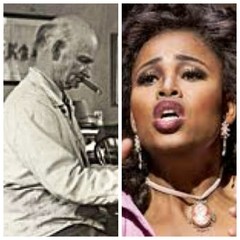|
Back
The Nature of the World New York
Isaac Stern Auditorium, Carnegie Hall
06/05/2018 -
Carl Ruggles: Evocations
Wolfgang Amadeus Mozart: Exsultate, jubilate, K. 158a [165]
Gustav Mahler: Symphony No. 4 in G Major
Pretty Yende (Soprano)
The MET Orchestra, Michael Tilson Thomas (Conductor)

M. Tilson Thomas (© Samuel A. Dog)
“Music that doesn’t surge isn’t great music”
“Composing is soul-searching. Nothing is ever finished.”
Carl Ruggles (1876-1971)
Whatever one thought about Michael Tilson Thomas’ Mahler last night, his mastery of Carl Ruggles’ Evocations was more than a wonderment. It was an epiphany of 20th Century music.
Maestro Thomas has always underscored his eclectic career with contemporary music, he has taken composers like Charles Ives, establishing the composer which Bernstein had pioneered, into the mainstream of the concert hall. (Ives would have hated that, but so be it!)
Carl Ruggles is a more difficult case. In a fascinating talk before the music, Mr. Thomas talked about his friendship with Ruggles in the composer’s last years, mentioning that he had composed only twelve works in his 95 years. (That is a bit outdated, since Donald Berman has discovered, with John Kirkpatrick even more music.) The composer had never actually “finished” each piece, but rewrote over and over and over again each work. His four Evocations were typical. The piano pieces were constantly re-composed, and the orchestral versions were never finished.
Yet, for this, my first performance, I am so happy that it was Mr. Thomas who directed.
Ruggles might be associated musically with Ives (as they were crotchety Olde New England friends), but Ives is, in a way easier. Just when you’re dazzled by his punches, he brings in a piece of Americana: a hymn or anthem or march for us to anchor ourselves into his reality.
Ruggles was the total abstract, with no points of recognition save theart itself, a Jackson Pollock painting with huge splotches of fortissimo paint and no anchors. He could start off the first two Evocations with quiet lines, and suddenly burst into dissonant fury. He might start a march, as in the third piece, then bring it down, then sound up the orchestra again.
In a way it was more Webern than Ives-like. Each piece around three minutes long, darting about, lifting up the orchestra, playing it down. I was tempted to call the piece Germinations rather than Evocations. They evoked nothing at all–but they germinated like some alien flower from seed to hulking trunk to knotty branches, an occasional bud, then back to the ground again.
The genius of Mr. Thomas last night was how melodious, how lyrically he conducted those gnarly measures. They will never be fluid, they never coalesce except to scholars. But Mr. Thomas gave them the energy and spirit to make them–and Carl Ruggles–to live and hopefully prosper.

C. Ruggles/P. Yende
The full MET Orchestra did those honors. And one was thankful that they disappeared after the Ruggles, giving us a break before returning as an 18th Century ensemble for Mozart’s three-movement motet, Exsultate, jubilate.
The piece could have been titled Concerto for Castrato. Though rabbinical moils are not permitted to go the whole hog (so to speak), so the work is performed by soprano and orchestra. (One must compromise with modern trends, alas.) And the MET Orchestra had a stunning soprano in the South African-born Pretty Yende. Her voice is luscious, resonant, clear as a bell. Her range in this most difficult work goes way over high C, and she reached it in the cadenza with no problems.
At the same time, at the age of 16, Mozart couldn’t help showing off his artist all the bel canto melismas and operatic arts possible, and Ms. Yende, already an international star specializing in bel canto opera, had few difficulties here. How any soprano can put together the operatic melodies of the first two movements with that glorious made-for-church Allelujah is a problem. Her two personalities were satisfactory enough. But we had to wait for the Mahler Fourth Symphony to give us a single musical personality.
Mentioned before was Michael Tilson Thomas as a prime advocate for 20th and 21st Century music. Raised in the artistic hotbed of Los Angeles, that was natural. Quite un-natural was how he and his San Francisco Orchestra became recognized for the most stunning Mahler of the 21st Century.
That is of course an outrageous statement. Mahler has no ideal. His ideas are so subjective, such a product of both post-Romantic and Freudian excesses, that no conductor can resist placing their own prints on these symphonies.
The Fourth, though, has no inner ailments, its heart is blatantly on its sleeve. And hearing Maestro Thomas conduct, one understands why Mahler was considering composing Hansel and Gretel. (The result was a single song.) The first movement, with its sleigh-bells, its plethora of themes, its trumpet call–in this case sounding like a toy trumpet from Leopold Mozart’s Toy Symphony–all give a picture of a child in nature. His First Symphony had been a painting of nature itself. Here, Mr. Thomas produced bird-calls from the woodwinds, the horn calls (produced masterfully without a single error by the MET’s Joseph Anderer) came from a Grimm Brothers forest, that whole movement with its squishy strings and sudden timpani was a dream sequence.
Mr. Thomas continued with an equally dreamy second movement, highlighted by the “out-of-tune” violin by David Chan. Yet when he put down the “vulgar” fiddle (that was Mahler’s word) and picked up his own instrument for the center of this movement, that was when the Hansel and Gretel reference came through, They had been through the forest in the Pensive, not hurried first movement. Here the children could look at the sky, listen to an angel sing an angelic song and then sleep again.
The conductor solved another mystery for me in the idyllic Restful third movement. Previously, I had thought the climax, that huge orchestral explosion of strings and harp and timpani and brass coming in the background, was almost an interruption of the restful previous motions.
That is the usual effect. Mr. Thomas made it inevitable, even as his tempo was a bit slower than usual. Just as the gorgeous Alleluja burst through Mozart’s previous operatic movements, here Mr. Thomas made certain the sounds were never static, that the MET Orchestra moved inevitably to that heavenly choir, as if, yes, he was giving his own Allelujah to the pantheistic prayers. Perhaps the strings of the MET were not up to their Viennese or NY Phil or even San Francisco colleagues, but Maestro Thomas made them transcendent, and the soft glissando octaves leading to the coda were unspeakably lovely.
One doubts that any soprano is “ideal” for the final movement. Too technically brilliant? They lose the naivety of the poems. Too simple? One loses the Mozartean genius of the melody. Too perfect? The hushes of the orchestra become lost in the wonderment of songs.
Pretty Yende was still splendid here. The voice was operatic, yes, but she restrained her operatic talent, she sung with simplicity, her German was clear, her vocal emotions were confined This was as good as it comes. And Michael Tilson Thomas’ conducting was as euphonious and ingenuous and enrapturing as this work deserves.
Harry Rolnick
|